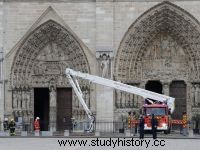Two years after the fire that destroyed the frame, the spire and the roof of the cathedral, oaks are selected and taken from all regions. The restored building is supposed to be inaugurated in April 2024.

These oaks that we cut down... This one will be used for the framework of Notre-Dame.
There will be around sixty from Haute-Saône, 300 from Nièvre and Yonne, 150 from Ile-de-France, around fifty from Alsace, around a hundred others from the forest of Mormal in the North, about twenty from the forest of Chandelais in Maine-et-Loire, 30 will be taken from the forest of Loches in Indre-et-Loire. And then in Sarthe, Eure, Ardennes, Vienne, around Reims, Aquitaine, Brittany... It's very simple, it's from all over France that the oaks will come from to be used to rebuild the frame and spire of Notre-Dame de Paris. In the evening and night of April 15, 2019, they were completely destroyed, along with the lead roof, in the fire that ravaged the Paris cathedral.
The disappearance of the spire left a gaping hole at the crossing of the transept and a vault collapsed in the nave. Since then, the site on the Ile de la Cité has become a vast construction site, animated by the clearing and sorting of the remains, which is in the process of being completed, the consolidation with wooden props of the weakened building, the decontamination of the area and its surroundings polluted by lead particles dispersed by the smoke from the fire. Soon the actual restoration can begin.
An identical reconstruction of the arrow
On the stone side, the Bureau of Geological and Mining Research (BRGM) is going around the quarries of the Paris basin to find out where to find a material compatible with the building. On the wood side, things are more advanced. The debates around whether or not to rebuild the spire and how to redo the frame have for a time agitated specialists, historians, architects and simple enthusiasts. But the matter was decided in July 2020 by the Public Establishment responsible for the restoration of the cathedral, following a meeting of the National Commission for Heritage and Architecture. The frame will be rebuilt in oak wood, surmounted by an identically redone spire.
SLIDESHOW. The major construction site of Notre-Dame after the fireA specification specifies the request:you need sturdy trees, straight, without knots, without frostbite (a defect in the wood caused by the action of frost). They will be between 50 to 90 cm in diameter and 5 to 14 meters long from the log if they come from private estates. The state forests will give the tallest trees, between 15 and 21 meters. The largest and oldest specimens (some, taken in the forest of Bercé in the Sarthe, are bicentennial) will be used for the arrow.
Assembly of the framework will begin in 2023
If the National Forestry Office has undertaken to provide 325 oaks, a real tour of France of forests, including private ones, has been set up to find the 1,300 trees needed for the project. The initiative is an obvious communication coup, with the slight taste of federation of a people around a common cause. In any case, the cut had to be done before the spring sap rose. It was therefore in March 2021 that the slaughter did indeed begin, almost everywhere, including in a sometimes very symbolic way. The forest of Paimpont, in Brittany, will provide eight oaks, that of Vouillé-Saint-Hilaire, in Vienne, three, and two hundred-year-old trees will come out of that of Vicq-sur-Breuilh in Haute-Vienne. The villages of Faymont (300 inhabitants), in Haute-Saône, or Poligny (4000), in the Jura, can be proud of having brought an oak tree each.
Concretely, the professionals of the National Federation of Wood, who created an ad hoc organization called France Bois Notre-Dame, select and collect the trees on a voluntary basis to then distribute them in the sawmills. Once trimmed, the beams will be left to rest for between a year and a year and a half. In early 2023, assembly will begin. The official calendar wants Notre-Dame de Paris to be inaugurated with a Te Deum on April 16, 2024.


